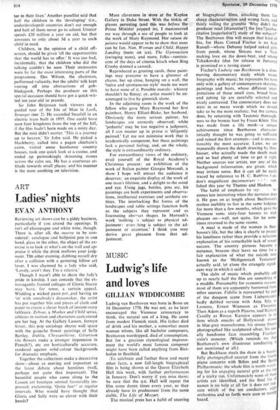MUSIC Ludwig's life and loves
GILLIAN WIDDICOMBE
Ludwig van Beethoven was born in Bonn on 16 December 1770. He was not, as he later encouraged the Viennese aristocracy to think, the natural son of a king. He came from modest Flemish stock. His father died of drink and his mother, a somewhat mean woman whom, like all bachelor composers, Beethoven worshipped, died of consumption. But for a gracious etymological improve- ment the world's most famous composer might have been called anything from Biet- hofen to Beetfield.
-To celebrate and further these and many other facts, a new full-length biographical film is being shown at the Queen Elizabeth Hall this week, with further performances in January. Don't worry if you miss them; be sure that the Q.E. Hall will repeat the film some dozen times every year, as they already have its predecessor from the same stable, The Life of Mozart.
The musical press has a habit of sneering
at biographical films, attacking them for cheap characterisation and wrong facts, and thinly veiling the grumble 'Why didn't the producer read [dramatise?] the [my?]autho- ritative [superlative?] study of the subject?' The Beethoven film will escape that kind of fire, for Hans Conrad Fischer is no Ken Russell—whose Debussy helped naked girls from ponds, whose Strauss was a Nazi making love on the down-beat, and whose Tchaikovsky (due for release in January) is promised as a raving queer.
Fischer's Ludwig van Beethoven is a slow- moving documentary study which mixes biography with music; he represents his hero only with a gallery of-contemporary sketches, paintings and busts, whose different inter- pretations of those small eyes, broad brow and jutting lip are carefully selected and nicely contrasted. The commentary does not state in so many words which we should take to be the most realistic; but the camera does, by returning with Teutonic thorough. ness to the bronze bust by Franz Klein. This was made from a life mask—a unique achievement since Beethoven character- istically thought he was going to suffocate and ruined the first attempts—and is unques- tionably the most accurate. Later, we are repeatedly shown the death drawing by Dan- hauser, who actually made the death mask and so had plenty of time to- get it right. Neither sources nor artists, nor any of this background information, are given; which may irritate some. But it can all be easily traced by reference to H. C. Robbins Lan- don's magnificent documentary ..••• ' • nub- lished this year by Thames and Hudson.
The habit of emphasis by rep
tie- comes less interesting when the narrator does it. He goes on at length about Beethoven's restless inability to live in the same lodgings for more than a few months, which gave the Viennese some sixty-four houses to stick plaques on—well, not quite, for he some- times returned to the same rooms.
A meal is made of the women in Beet- hoven's life, but the idea is clearly to project his loneliness rather than provide a salacious explanation of his remarkable lack of sexual success. The country pictures become a nuisance, because they leave no time for a fair explanation of what the suicide note known as the 'Heiligenstadt Testament' actually said, let alone the strangely signifi- cant way in which it said it. The slabs of music which probably add up to nearly half the film are something of a muddle. Presumably for economic reasons, most of them are apparently borrowed from other sources. Fidelio is represented by part of the dungeon scene from Liebermann's badly dubbed version with Anja Silja as Leonora, Ernest Wiemann as Florestan. Theo Adam as a superb Pizarro, and Richard Cassilly as Rocco. Karajan appears in an item which smacks of Hollywood: shown in blue-grey monochrome, his strong fingers photographed like sculptured silver, his usu• ally handsome face resembling Franken- stein's monster. (Which reminds me that Beethoven's own disastrous conducting i5 not mentioned at all.) But Backhaus steals the show in a beauti- fully photographed excerpt from the fourth piano concerto with Bohm and the Berlin Philharmonic: the whole film is worth watch- ing for his engaging natural grin at the top of a tricky run. Unfortunately none of these artists are identified, and the final list of names is no help at all for it does not indi- cate which of the ten conductors, eight orchestras and so forth were seen or merely heard.






































 Previous page
Previous page